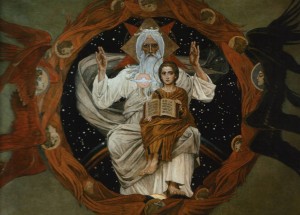 This image, “The Holy Trinity of God,” by Viktor Vasnetsov is a rather interesting image for Christians.
This image, “The Holy Trinity of God,” by Viktor Vasnetsov is a rather interesting image for Christians.
Some will say, with historical precedent, that this image of the Trinity is heretical because God the Father cannot be depicted in a human form. The proponents of a biblical and liturgical theology state that God the Father is invisible and unable to be depicted in matter. Jesus Christ was born of the indescribable Father, therefore the Father cannot depicted be in an image. Having said this, it has not stopped artists from attempting to show us the Father. The Russians are noted for this.
I happen to like this image but I understand the caution and even the rejection of the image. For many, this issue may an Eastern Christian matter and not a Western one. It is, however, not that easy to say that this is a matter for one portion of the Church and not another. There is something called the unity of faith.
The teaching comes from 7th Ecumenical Council in AD 787, Second Nicea which focussed on the place of iconography in the Church and the very heated controversy between the iconoclasts and the iconodules. No doubt I can’t deal with the whole of the Council but the teaching of the Church was formulated by Saint John of Damascus who said,
- Concerning the charge of idolatry: Icons are not idols but symbols, therefore when an Orthodox venerates an icon, he is not guilty of idolatry. He is not worshipping the symbol, but merely venerating it. Such veneration is not directed toward wood, or paint or stone, but towards the person depicted. Therefore relative honor is shown to material objects, but worship is due to God alone.
- We do not make obeisance to the nature of wood, but we revere and do obeisance to Him who was crucified on the Cross… When the two beams of the Cross are joined together I adore the figure because of Christ who was crucified on the Cross, but if the beams are separated, I throw them away and burn them.
The Second Council of Nicea formally taught as a result of the Damascene:
- Icons are necessary and essential because they protect the full and proper doctrine of the Incarnation. While God cannot be represented in His eternal nature (“…no man has seen God”, John 1:18), He can be depicted simply because He “became human and took flesh.” Of Him who took a material body, material images can be made. In so taking a material body, God proved that matter can be redeemed. He deified matter, making it spirit-bearing, and so if flesh can be a medium for the Spirit, so can wood or paint, although in a different fashion.
- I do not worship matter, but the Creator of matter, who for my sake became material and deigned to dwell in matter, who through matter effected my salvation.
Now, where do we go from here? In my mind I think of this issue as very similar to the biblical prohibition from pronouncing he name of God (YHWH). Recall that Benedict XVI asked Catholics to respect this biblical discipline. Sadly, Catholics can have a rather bold and sometimes arrogant approach to some things…